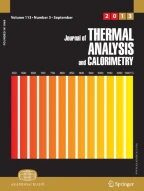Abstract
Thermoanalytical instruments are extensively used in R&D as well as in industrial quality control. A quantitative analysis of the data of a thermoanalytical measurement requires a careful calibration of the instrument. In differential scanning calorimetry (DSC) the quantities that have to be calibrated are the temperature and the heat flow. These two quantities are usually calibrated by evaluating melting or solid-solid transitions of some reference materials with well known transition enthalpies and temperatures. In this contribution we investigate temperature and heat flow calibration in the temperature range between −100 and 160°C. We included 9 different samples for the analysis and established some general rules for the calibration process. As a result we found that with a well calibrated instrument the heat flow can be measured with 90% confidence to about ± 3% accuracy in this temperature range. With respect to temperature calibration we find that accuracies of ±0.8°C (90% confidence) may be expected. These values represent general accuracy limitations of DSC’s due to varying heat transfer conditions within the samples.
Similar content being viewed by others
Explore related subjects
Discover the latest articles, news and stories from top researchers in related subjects.References
R. Riesen et al., Proc. 26th NATAS, 1998, 235.
S. M. Sarge et al., PTB-Mitteilungen, 103 (1993) 3.
R. Riesen and G. Widmann, Thermal Analysis, Hüthig-Verlag, 1987.
H. L. Finke et al., J. Am. Chem. Soc., 76 (1954) 333.
G. Hakvoort, J. Thermal Anal., 43 (1994) 1551.
ITS-90. H. Preston-Thomas, Metrologia, 27 (1990) 3.
J. Emsley, The Elements, Clarendon Press, Oxford 1991.
H. K. Cammenga et al., Thermochim. Acta, 219 (1993) 333.
Author information
Authors and Affiliations
Rights and permissions
About this article
Cite this article
Schubnell, M. Temperature and Heat Flow Calibration of A DSC-instrument in the Temperature Range Between −100 and 160°C. Journal of Thermal Analysis and Calorimetry 61, 91–98 (2000). https://doi.org/10.1023/A:1010156407261
Issue Date:
DOI: https://doi.org/10.1023/A:1010156407261
